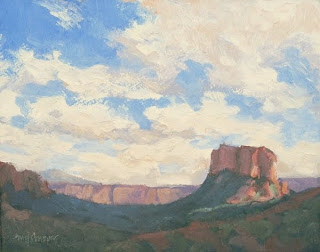
"Prickly Pears & Juniper" 9x12, oil
(revised)
"Prickly Pears & Juniper" 9x12, oil
(original)
Don't fall in love - with any part of your painting, that is. It's easy to fall in love with this part and that part. You may fall in love with a cloud that went down perfectly with a single brush stroke or a tree that really "makes" the composition. But in the end, you may find that the cloud or tree doesn't quite fit your vision. If scraping out this element will improve the painting or give you a chance to paint it better, do so. If you don't, it'll haunt you.
The other day, I wrote about cropping a piece to make a more effective composition. As a footnote, I mentioned that the painting could be adjusted with color and value shifts to also improve it. Another method is to scrape and re-paint the area that's causing the problem. In the original version of the revised painting above, two areas were fighting for the viewer's eye: the odd-shaped background hills and the more-crisply painted prickly pears in the foreground. (The revised is on top; original on the bottom.)
I wanted to move the emphasis to the prickly pears. The background hills had a peculiar and distracting shape. ("But they really were that way!" Doesn't matter; you're the designer in this case, improving on nature.) So, I scraped them down and repainted the area. I made the hill shapes more generic and also lessened the contrast a tad and cooled off the color. You can see how the emphasis on the revised painting has moved to a better location, and the fight for attention is over. I'm not saying the revised version here is a great painting, but it's a better painting, for sure.
Never convince yourself that you should keep a bad painting "as is" for a reminder of what you need to improve on. Scrape out the element, and if the painting requires it, paint it again - and scrape it yet again, if it still isn't right. Repainting an area is akin to painting a whole new painting and adds to that proverbial "miles of canvas" they say you must paint before you get become a good painter.
It's hard to do. "Maybe no one will notice," you may say. Well, they will. Even if they don't have a trained, critical eye, they'll sense something out of kilter.
Get a painting knife and keep it in your plein air kit. It'll be a good teacher.






 "Mingus View" 8x10, oil/paper - contact Michael
"Mingus View" 8x10, oil/paper - contact Michael